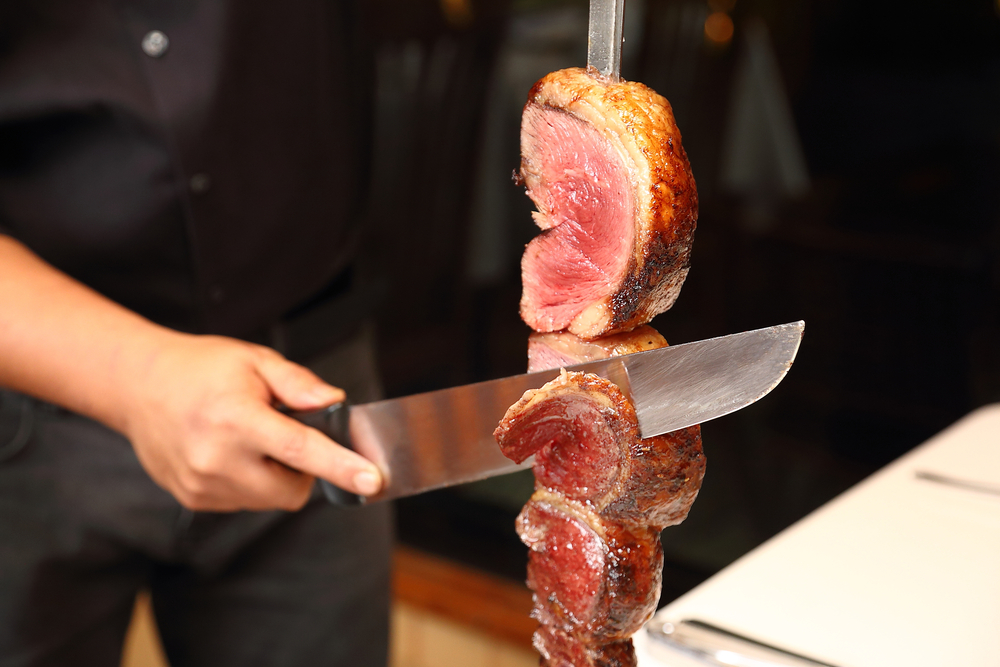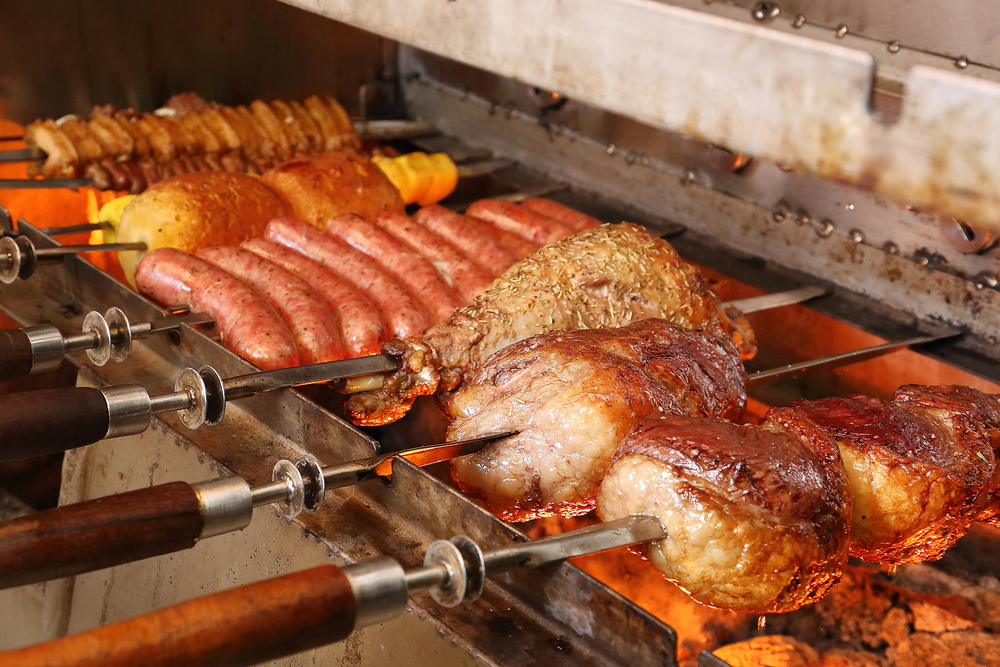Table of Content
ToggleIntroduction
Churrasco is a culinary tradition that stands at the heart of Brazilian culture, embodying a confluence of flavor, social gathering, and historical significance. This method of grilling meat, which originated in the southern regions of Brazil, has evolved into a national symbol that resonates with the collective spirit of the country. It goes beyond mere cooking techniques; churrasco represents a festivity, an art form that brings together families and friends, reinforcing social bonds through the shared experience of enjoying succulent cuts of meat.
Reflecting the diverse nature of Brazilian society, churrasco incorporates a variety of meats and cooking styles, serving as a testament to the country’s rich agricultural heritage. Its prevalence in Brazilian steakhouses, known as ‘churrascarias’, showcases the importance of this gastronomic tradition. These establishments offer an all-you-can-eat style service where passadores, or meat servers, roam from table to table with skewers of freshly grilled meat. This distinctive service style is a direct reflection of churrasco’s social aspect, as it encourages interaction and a convivial atmosphere among diners.
Key Takeaways
- Churrasco is a deeply rooted Brazilian tradition that signifies more than just cooking meat; it is a social event.
- Various meats and grilling techniques come together to define the churrasco experience, which is central to Brazilian culture.
- Churrascarias exemplify the communal and interactive nature of churrasco dining, enhancing its role in social gatherings.
History and Origin of Churrasco
Churrasco reflects the depth of Brazilian heritage, encompassing the traditions of the gaúchos of southern Brazil and their significant cultural imprint. It serves not just as a culinary practice but as a symbol of the historical lifestyle on the pampas.
Gaucho Roots
Churrasco originated with the gaúchos, the cowboys of the pampas in Southern Brazil. On these vast plains, the gaúchos developed the technique of roasting meat over open fire after a long day of cattle herding. This method was not just a means of sustenance but became a cherished aspect of their cultural heritage. Life in the pampas demanded resourcefulness and simplicity, and the gauchos’ way of grilling meat was a reflection of this lifestyle.
Spread to Urban Areas
As urbanization grew, churrasco began to permeate cities, moving from the cowboy fire pits in the countryside to Brazilian backyards and restaurants. This transition brought churrasco to the larger population, transitioning from a rustic cooking method to a nationwide tradition, celebrated in both homes and commercial churrascarias. Consequently, the cultural significance of churrasco magnified, symbolizing a nostalgic homage to the gaúchos and their storied past. The spread of the practice has also highlighted churrasco as a unifying element in Brazilian culture, intertwining the urban and rural experiences.
Typical Cuts and Meats Used
In Brazil, churrasco is more than just a meal; it is a cultural embodiment that showcases a variety of meats and cuts. Each selection plays a distinct role in the churrasco experience, from traditional beef favorites to diverse offerings of pork, lamb, and chicken.
Beef Favorite Cuts
When it comes to beef at a churrasco, three cuts stand out for their popularity and flavor:
- Picanha: This is the prime cut and the most beloved in Brazilian barbecue. It’s known for its succulent fat cap that imparts rich flavor when grilled.
- Fraldinha: Also known as flap meat, this cut is highly flavorful and has a tender, juicy texture, making it ideal for the high heat of churrasco.
- Costela: Beef ribs, or costela, are savored for their marbling and slow-cooked tenderness. They are often seasoned simply with sea salt to enhance the natural taste of the meat.
Pork, Lamb, and Chicken Options
Though beef is the star, other meats offer variety to the churrasco experience:
- Pork: Variously presented as sausages or tenderloin, pork is a common churrasco choice. The meats are typically seasoned and grilled to achieve a crispy exterior.
- Lamb: Lamb is increasingly popular in Brazil, often prepared as sausage or as choice cuts that are appreciated for their distinct, rich flavor.
- Chicken: Traditionally, chicken is marinated and grilled, sometimes served as sausages ‘frescal’, or as hearts, which are a specialty on their own.
With a variety of textures and flavors, these meats and cuts contribute to the rich tapestry of Brazil’s churrasco tradition.
Churrasco Cooking Techniques
Churrasco, a celebrated Brazilian barbeque style, centers around diverse grilling methods and a distinctive use of skewers. These techniques are deeply rooted in tradition and have become synonymous with the rich culinary identity of Brazil, showcasing an adeptness at cooking various meats to perfection over open flames.
Grilling Methods
Brazilian churrasco utilizes an array of grilling methods that impart a unique flavor profile to the meats. Primarily, hardwood charcoal or wood is used, which contributes to a smoky essence. This grilling style is not only about using specific types of fuel such as charcoal or wood but also about controlling the temperature and the distance between the meat and the open fire. Meat is often cooked on large grills that allow it to be raised or lowered, adjusting the intensity of the heat provided by open flames.
Skewer and Rodizio Style
The use of skewers (espeto) is a defining characteristic of churrasco. Large cuts of meat are impaled on long metal skewers and slowly roasted over an open fire. This cooking technique ensures an even cook and a succulent finish to a variety of meats, from beef to chicken and pork.
Rodizio style service is a dynamic and communal dining experience where these skewered meats are brought to the table in succession and sliced directly onto the diner’s plate. It’s both a cooking and service method involving continuous table-side service of various types of meats, sliced and served by the passadors (meat waiters) who roam the dining area offering a steady flow of culinary delights.
Through these meticulous cooking practices, churrasco highlights the value of precise heat management, the authentic use of natural materials, and the importance of a show-stopping presentation, which all combine to define this cherished Brazilian culinary tradition.
Churrascarias: Brazilian Steakhouses
Churrascarias, or Brazilian steakhouses, epitomize the country’s passion for high-quality grilled meats and a lively dining atmosphere. These establishments are celebrated for their all-you-can-eat rodizio service and a variety of traditional Brazilian side dishes that complement the churrasco experience.
Steakhouse Experience
Churrascarias immerse diners in the essence of Brazilian culture through the art of churrasco, an authentic method of barbecuing meats. Brazilian churrasco typically involves a range of meats from beef to lamb, skewered and grilled over an open flame. The steakhouse ambiance is vibrant, with waiters bustling between tables to offer a continuous supply of succulent cuts directly to patrons’ plates.
Rodizio Service
The hallmark of many churrascarias is the rodizio style service where waiters, known as gauchos, rotate around the restaurant with skewers of freshly grilled meats. Diners signal the gauchos using a small marker at their table — green to continue service, and red to pause — allowing for a customizable all-you-can-eat experience. The experience is not merely about quantity but quality and variety, catering to every preference.
Side Dishes and Accompaniments
At a Brazilian steakhouse, the meats are accompanied by an array of side dishes that are as integral to the experience as the churrasco itself. Hearty beans, fluffy rice, and the tangy salsa called vinagrete are staples. Farofa, toasted cassava flour, is often sprinkled on meat for extra texture. At some establishments, the Brazilian national dish, feijoada — a stew of beans with beef and pork — is a celebrated side. Pão de queijo, or cheese bread, and crisp salads add balance to the rich flavors on offer.
Sauces and Seasonings
In the Brazilian culinary tradition, churrasco is elevated by its sauces and seasonings which are pivotal to its unique taste and cultural significance. They mark the distinction of flavors for which Brazilian barbecue is world-renowned.
Traditional Seasoning
In the realm of traditional seasoning for churrasco, simplicity leads the way. A typical Brazilian steak is generously seasoned with coarse salt that crisps up during grilling and enhances the meat’s natural flavor. Garlic and olive oil often join the stage as fundamental additions—sprinkled or rubbed onto meats before they face the heat. It’s this uncomplicated blend that locks in an authentic sizzle adored across Brazil.
- Garlic: Crushed or minced, it’s a time-honored taste enhancer.
- Olive oil: Drizzled on meat, serves both as a marinade and a moisture-retainer.
Accompanying Sauces
As for the sauces that accompany a Brazilian churrasco, chimichurri stands as an iconic choice. Originating from South America, this sauce combines garlic, olive oil, vinegar, and a variety of herbs into a tangy marinade that doubles as a dressing, infusing the meat with layers of zesty flavor.
- Chimichurri Sauce: A vibrant blend, usually involving parsley, oregano, and red pepper flakes, that’s not just a marinade but is often served on the side for dipping or drizzling.
The right seasoning and sauces not only tenderize and preserve the meats but also complement their smoky and juicy profile. They express the gastronomic values that are central to Brazilian heritage, underscoring both the ritualistic and flavorful experience of churrasco.

Social and Cultural Aspect
Churrasco is not merely a method of grilling meat but a tradition deeply embedded in Brazilian society, symbolizing hospitality and the joy of sharing during social gatherings. It reflects the cultural significance and the festive spirit often accompanied by music and dancing.
Churrasco as a Social Gathering
In Brazil, churrasco serves as a significant social event, epitomizing more than just a culinary practice—it’s a means of bringing people together. These events are a representation of comida farta, a plentiful meal where generous portions signify abundance and hospitality. Social status often influences the prestige value of foods, and churrasco holds a high place due to its historical and cultural roots. In gatherings, not only is food shared, but so are stories, laughter, and often a round of chimarrão—a traditional caffeine-rich drink.
Impact on Brazilian Culture
Churrasco’s influence stretches across various aspects of Brazilian culture, including the noted gaúcho culture in the south, particularly in the state of Rio Grande do Sul. As a cultural symbol, churrasco underscores the importance of comradery and the notion of celebration. During such events, elements of gaucho culture surface through attire, music, and the ceremonial style of meat preparation and serving. Cultural celebrations frequently integrate churrasco, showcasing the blend of indigenous and European influences within Brazilian culinary traditions.
Churrasco Influence Worldwide
Churrasco, the Brazilian style of barbecuing, has transcended its origins, embedding itself in the culinary traditions of various countries and inspiring the establishment of themed restaurants across the globe. This section explores how churrasco has adapted outside Brazil and the proliferation of churrasco style restaurants abroad.
Adaptation Outside Brazil
Churrasco has demonstrated its versatility by adapting to local tastes and preferences outside Brazil. In the United States, churrascarias like Fogo de Chão have customized their menu to suit American palates, adding side dishes that resonate with local diners. Meanwhile, Uruguay and Argentina, with their strong tradition of grilling, have incorporated aspects of Brazilian churrasco into their culinary repertoire, blending it with their own barbecuing techniques and creating a unique South American barbecue experience.
Churrasco Style Restaurants Abroad
Internationally, churrasco style restaurants operate under various monikers such as Tucanos and Rodizio Grill. In these establishments, the rodizio service—an all-you-can-eat style of restaurant service common in Brazil—is a particularly popular feature. Tucanos offers a twist on the standard churrasco by providing a festival atmosphere with a parade of grilled meats that are a testament to the original festive culture of Rio de Janeiro. On the other hand, eateries like Rodizio Grill have expanded further into the international scene, enhancing global exposure to the Brazilian way of grilling. The influence of churrasco is not limited to standalone restaurants but extends to culinary events and festivals, further solidifying its international presence.

Buying and Preparing Churrasco at Home
In Brazil, churrasco is more than just a meal—it’s a celebrated tradition of home cooking that takes pride in the quality of the meat and the mastery of grilling techniques. To experience authentic churrasco at home, one must carefully select high-quality meats and understand the essentials of skilled grilling.
Selecting Meats
When purchasing meat for churrasco, visiting a local butcher known for high-quality meat is paramount. The selection encompasses various cuts, with picanha (rump cap) being a cherished choice due to its rich flavor and tender texture. Ribeye and alcatra (top sirloin) are also popular for their marbling, which enhances taste when grilled. One should always look for meat with a vibrant red hue and consistent fat marbling.
- Recommended Cuts for Churrasco:
- Picanha
- Ribeye
- Alcatra
Home Grilling Tips
Grilling meat at home to achieve the level of Brazilian churrascarias involves a thorough understanding of working with an open flame. Prepare a grill for embers rather than a roaring fire, as controlled heat is crucial for even cooking. Meat should be placed on the grill and turned only once to retain juices and develop a crispy exterior. Grillers often season with only salt to not overshadow the natural flavor of the grilled meat.
- Grilling Steps:
- Ignite the charcoal and wait for it to reach a glow.
- Season the meat with coarse salt.
- Sear the meat over high heat, then move to a cooler part of the grill to cook slowly.
- Turn the meat only once to ensure juiciness.
- Let the meat rest before serving to allow the juices to redistribute.
Embracing these practices, churrasco becomes not just a dish but a joyful expression of Brazilian culture in the comfort of one’s home.
Frequently Asked Questions
Churrasco is a beloved traditional Brazilian style of barbecuing meats, which has garnered attention for its unique flavors and dining experience. Here are some specifics you might find helpful to understand its value.
What is the average cost of a meal at a Brazilian steakhouse in Brazil?
The cost of a meal at a Brazilian steakhouse in Brazil varies; however, patrons can expect to pay around R$50 to R$150 per person, depending on the location and the prestige of the restaurant.
How does the price of churrasco in Brazil compare to other countries?
Churrasco pricing in Brazil is typically lower than in other countries due to local sourcing of meats and the reduced overhead costs associated with domestic supply chains.
Which cuts of meat are typically featured at a Brazilian steakhouse?
A Brazilian steakhouse generally offers a variety of cuts including picanha (rump cap), alcatra (top sirloin), and fraldinha (bottom sirloin). These cuts are well-known for their succulence and flavor.
What are the common side dishes served with churrasco in Brazilian steakhouses?
Common side dishes include farofa (toasted cassava flour mixture), rice, black beans, and fresh salad. These sides complement the richness of the meats served.
Can you explain the dining experience at a typical Brazilian steakhouse?
The dining experience at a Brazilian steakhouse often involves a continuous service or ‘rodízio’ where assorted cuts of meat are brought to the table on skewers by servers, and customers signal whether they wish to be served more.
What factors contribute to the cost of a churrasco experience in Brazil?
Variables like the variety of meats offered, the quality of the ingredients, and the level of service are factors that contribute to the cost of churrasco in Brazil. Location and restaurant reputation also play a significant role in pricing.












